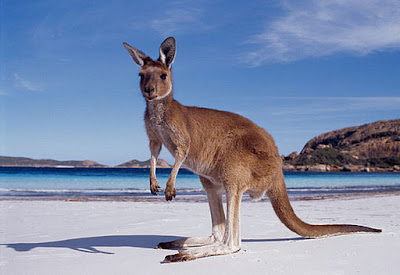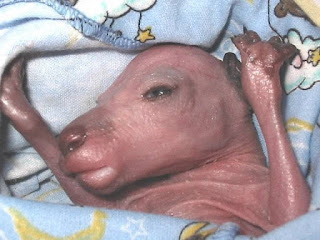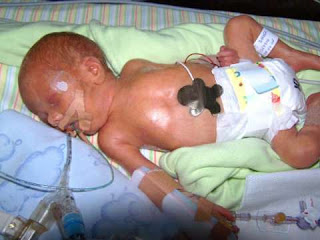Contrary to claims by regulatory agencies, the industry here in Australia is not fully professional, with a large proportion of casual shooters amongst licensees.
Kangaroos that are inaccurately targeted (not hit in the head from 80 to 200 metres at night) may suffer a painful, protracted death and their carcasses will not be utilised. Pouch-young joeys are clubbed on the head. Young-at-foot are supposed to be shot, but since the industry is self-regulated, they are often left to die of starvation or predation.
Taken together, it is likely that up to a million young are killed annually as collateral damage and their carcasses not used. This is an unacceptable practice by international standards. They are the by-products of the greatest massacre of wild animals in the world. In a similar case of harvested terrestrial wildlife, the products derived from young Canadian Harp Seals – which are clubbed to death – have been banned in most westernised countries.
Red kangaroos are now being killed at a rate three times higher than they are reproducing. In the 1960's their average age was 12; today it is 2. Their average weight was 35 kg in the 1960's, which
today is 18kg. Commercial killing has put insupportable pressure on Red kangaroos which now threatens the species.
Australia has the highest rate of extinctions in the world but there appears to be no shame, only apathy about this appalling record.
The soft padded feet and long tail of the kangaroo are integral to the ecological health of the land as regenerators of native grasses. It is destructive agricultural practices on marginal land that are proving to be unsustainable.
The best methods for dispatching joeys include beheading them or stomping them beneath your boot. The bigger ones you grab by the back legs and smash against a nearby rock or even the truck’s tire. After we killed five or six ‘roos, Craig a shooter would stop to gut them, pulling the babies out to dispatch them en masse. After one such performance Craig peered at me through the swirling dust and sighed.“Mate, I’ve been doin’ this for fifty years, and this part always makes me feel like such a ****
A Shooters Story
I was a professional kangaroo shooter 38 years ago. Now I spend an inordinate amount of time in the defence of animals that are doing poorly at the hands of humans.
You may ask as to what has led me to do a complete turnabout in my thinking, and expect some profound answer explaining that at such and such a moment in time the sky opened up and all of a sudden I saw the light. Sorry to disappoint, but it did not happen this way.
If there is any profundity in my "conversion", it is that I have come to the realization that we are all led down differing paths in life by our genetic make-up and the circumstance that we find ourselves in.
In my case, 38 years ago, the whole social, political and animal concern scene was vastly different to today's. There was a predominate attitude of human matters being at the fore of thought and a mish-mash of ideas when dealing with the other animals on the planet. On the one hand, personal pets were gaining in the welfare stakes, as were wild creatures that had "fluffy" appeal. On the other, domestic stock conditions were degrading rapidly into the factory farm situation that is still rampant to now.
This some decades of time saw European cities and other population centres around the Western World explode into greater awareness of the suffering of our "food". Unfortunately, socio/economic pressures, had rural climes, to a large extent, excluded from this expansion of a new way in thinking about the rest of nature.
In this distant past, the kangaroo was erroneously thought of as a pest that was diminishing the financial returns of those who depended on their income in outback areas.
This excuse was reasoning enough for kangaroos to be killed without compassion, for they were the enemy. Even so, I, and I would suggest, many other kangaroo shooters, were and are, very uneasy with the practice of having to kill Joey's on a never ending basis. It was not understood then, that the Joey-at-foot would also die in a state of terror by psychological deprivation, predation or starvation. Many kangaroo shooters now convince themselves that this joey escapes and lives happily ever after. Delusions of this sort are not uncommon in the industry and in governments and their acting agents.
Self-delusion played a big part in my experience as a kangaroo shooter but let me state here in the most unequivocal manner that is possible, to be able to self deceive is part and parcel of being human. There will be those that read this in a most judgmental way, comforting themselves with the thought that they could never had done such a thing as kangaroo shooting. Be very careful of that kind of thinking because it does not accord with the facts about the capacity of humanity to be inhumane to people and animals, given the right set of circumstance.
Be very careful that you are not self-deluding yourself on this point, for if you are, you are just the person who could be a kangaroo shooter if the situation dictated it so.
I do come across this kind of condemnation but it so insignificant when compared to the mental anguish I put myself through on a daily basis as to be non-existent. This will be carried till the day I die.
Thoughts of the terrible wounding and as stated, the slaughter of the innocents and now with greater knowledge, thoughts of the at-foot-Joey's left to fend for themselves in their thousands. Thoughts of taking the lives of countless numbers of kangaroos for convenient reasons. Thoughts of being a part of the juggernaut that was and is altering the genetic make up of a marvellous animal. Thoughts of my part in vilifying the kangaroo with the end result of it not having the awed respect, as it should, of the Australian people. Every time there is a wanton act of cruelty to kangaroos, I must bear some of the blame.
I stopped being a kangaroo shooter for many reason, with the cruelty only one of the many.
The kangaroo is not a pest and it is only the greedy and the foolhardy who believe it is a resource to be used at whim.
Australia must re-define its stubbornly inadequate definition of what is compassion and in doing so reap the rewards of not only doing the right thing, but the very tangible benefits of the eco-tourist dollar.
No doubt, other kangaroo shooters will read this, so it seems appropriate to leave a message for them.
If you can see past the self-delusion of what you are doing to other sentient and suffering capable creatures, for the sake of your future mind, do not wait for kangaroo shooting to be discarded as a remnant of our brutish past, as it will, but choose to get out now. The rest of your life will thank you for this very wise action.
This I guarantee.
The kangaroo is a universally loved icon yet millions are slaughtered to accommodate destructive agricultural practices.
David Nicholls
Write to David Nicholls with your support at the email address below.
ExKangarooShooter@hotmail.com
Australia's leaders hide behind a protective wall of propaganda and irresponsible legislation, so that a few may gain from the death of a species.
The best methods for dispatching joeys include beheading them or stomping them beneath your boot. The bigger ones you grab by the back legs and smash against a nearby rock or even the truck’s tire. After we killed five or six ‘roos, Craig a shooter would stop to gut them, pulling the babies out to dispatch them en masse. After one such performance Craig peered at me through the swirling dust and sighed.“Mate, I’ve been doin’ this for fifty years, and this part always makes me feel like such a ****
A Shooters Story
I was a professional kangaroo shooter 38 years ago. Now I spend an inordinate amount of time in the defence of animals that are doing poorly at the hands of humans.
You may ask as to what has led me to do a complete turnabout in my thinking, and expect some profound answer explaining that at such and such a moment in time the sky opened up and all of a sudden I saw the light. Sorry to disappoint, but it did not happen this way.
If there is any profundity in my "conversion", it is that I have come to the realization that we are all led down differing paths in life by our genetic make-up and the circumstance that we find ourselves in.
This some decades of time saw European cities and other population centres around the Western World explode into greater awareness of the suffering of our "food". Unfortunately, socio/economic pressures, had rural climes, to a large extent, excluded from this expansion of a new way in thinking about the rest of nature.
In this distant past, the kangaroo was erroneously thought of as a pest that was diminishing the financial returns of those who depended on their income in outback areas.
This excuse was reasoning enough for kangaroos to be killed without compassion, for they were the enemy. Even so, I, and I would suggest, many other kangaroo shooters, were and are, very uneasy with the practice of having to kill Joey's on a never ending basis. It was not understood then, that the Joey-at-foot would also die in a state of terror by psychological deprivation, predation or starvation. Many kangaroo shooters now convince themselves that this joey escapes and lives happily ever after. Delusions of this sort are not uncommon in the industry and in governments and their acting agents.
Self-delusion played a big part in my experience as a kangaroo shooter but let me state here in the most unequivocal manner that is possible, to be able to self deceive is part and parcel of being human. There will be those that read this in a most judgmental way, comforting themselves with the thought that they could never had done such a thing as kangaroo shooting. Be very careful of that kind of thinking because it does not accord with the facts about the capacity of humanity to be inhumane to people and animals, given the right set of circumstance.
Be very careful that you are not self-deluding yourself on this point, for if you are, you are just the person who could be a kangaroo shooter if the situation dictated it so.
I do come across this kind of condemnation but it so insignificant when compared to the mental anguish I put myself through on a daily basis as to be non-existent. This will be carried till the day I die.
Thoughts of the terrible wounding and as stated, the slaughter of the innocents and now with greater knowledge, thoughts of the at-foot-Joey's left to fend for themselves in their thousands. Thoughts of taking the lives of countless numbers of kangaroos for convenient reasons. Thoughts of being a part of the juggernaut that was and is altering the genetic make up of a marvellous animal. Thoughts of my part in vilifying the kangaroo with the end result of it not having the awed respect, as it should, of the Australian people. Every time there is a wanton act of cruelty to kangaroos, I must bear some of the blame.
I stopped being a kangaroo shooter for many reason, with the cruelty only one of the many.
The kangaroo is not a pest and it is only the greedy and the foolhardy who believe it is a resource to be used at whim.
Australia must re-define its stubbornly inadequate definition of what is compassion and in doing so reap the rewards of not only doing the right thing, but the very tangible benefits of the eco-tourist dollar.
No doubt, other kangaroo shooters will read this, so it seems appropriate to leave a message for them.
If you can see past the self-delusion of what you are doing to other sentient and suffering capable creatures, for the sake of your future mind, do not wait for kangaroo shooting to be discarded as a remnant of our brutish past, as it will, but choose to get out now. The rest of your life will thank you for this very wise action.
This I guarantee.
The kangaroo is a universally loved icon yet millions are slaughtered to accommodate destructive agricultural practices.
David Nicholls
Write to David Nicholls with your support at the email address below.
ExKangarooShooter@hotmail.com
Australia's leaders hide behind a protective wall of propaganda and irresponsible legislation, so that a few may gain from the death of a species.
























































